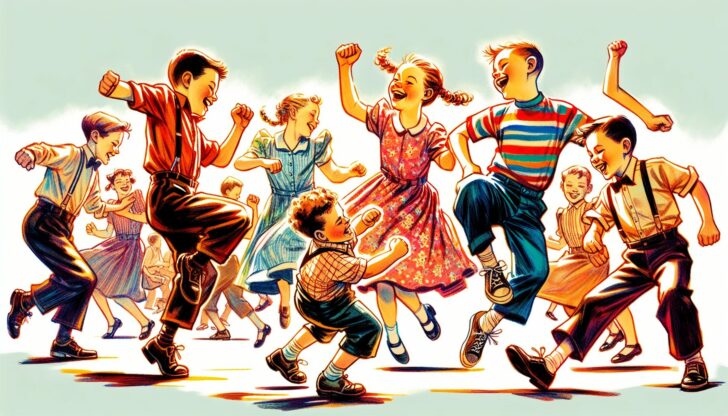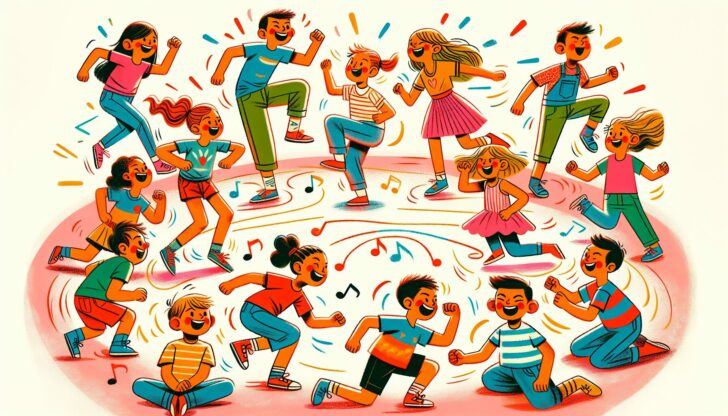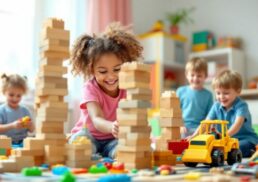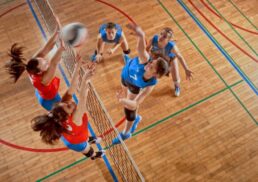Looking for ways to make your dance classes more engaging and fun? Dance class games are an excellent solution. These activities will not only energize your students but also help improve their skills and foster a positive class environment. In this article, we’ll share some of the best dance class game ideas that are sure to bring excitement and effective learning to your sessions.
Table of Contents
Key Takeaways
Incorporating dance games in classes boosts physical fitness, cognitive skills, and social-emotional growth while making lessons more engaging.
Dance games like Freeze Dance, Simon Says Dance, and Ribbon Dancing enhance coordination, memory, and creativity, making them ideal for students of all ages.
Adapting dance games to different skill levels and using positive reinforcement can create an inclusive, motivating, and enjoyable class environment.
Top Dance Class Game Ideas to Energize Your Students

When it comes to dance classes, incorporating fun activities can transform a regular session into an unforgettable experience. Dance games are an excellent way to enhance lessons, improve physical and cognitive skills, and foster social bonds among students. From physical benefits like improved coordination and balance to cognitive advantages such as better memory and problem-solving skills, dance games have it all. They also promote creativity, teamwork, and personal expression, making them invaluable tools for dance teachers.
We’ll now explore some top-notch dance class game ideas that will surely spark enthusiasm among your students.
Introduction
Dance games are a fantastic way to boost the energy and enthusiasm of your students. They provide a perfect blend of fun and learning, making dance classes more engaging and memorable. Whether you’re looking for warm-up activities, ways to help students master a new dance move, or simply want to create a positive and dynamic class environment, dance games are your go-to solution.
This blog post unfolds a plethora of dynamic and intriguing dance class game ideas, aiming to invigorate your students and instill a novel outlook in your teaching methods.
The Importance of Games in Dance Classes
Incorporating games into dance classes is not just about having fun; it’s a strategic approach to enhance the overall learning experience. Dance games can make classes more engaging, fostering a love for dance that goes beyond the studio. They provide a unique opportunity for students to exercise both their bodies and brains in diverse ways. Teachers can foster creativity, personal expression, and teamwork while assisting students in enhancing their technique, artistry, and socio-emotional skills by seamlessly blending play into dance training.
The benefits of dance games are multifaceted. They not only improve physical health and cognitive skills but also support social and emotional development. Dance activities help build friendships, boost confidence, and create a supportive community within the class. Utilizing play as an educational tool enables dance teachers to markedly augment their students’ learning outcomes and their overall enjoyment of the class.
Physical Benefits
Dance games promote physical activity, which is crucial for overall fitness and health. Activities like the Jumping Jack Dance help children burn excess energy and improve their stamina while having fun. Ribbon Dancing, on the other hand, enhances coordination and balance as students maneuver the ribbons through various patterns and shapes.
These games also encourage good posture and build muscle strength, contributing to better performance quality and physical development.
Cognitive Advantages
Engaging in dance games can significantly boost cognitive skills such as problem-solving, memory, and attention span. For instance, students are more likely to remember dance steps and concepts when they are presented in a fun and interactive way.
Educational dance games also help in enhancing coordination, planning, and concentration, making them an integral part of effective dance training.
Social and Emotional Growth
Dance games foster stronger interpersonal relationships and emotional development. By working together in activities like Mirror Dance or Animal Charades, students learn the value of teamwork and cooperation. These games also promote creativity and personal expression, allowing students to explore different emotions and build self-confidence.
The supportive community created through dance games can significantly enhance students’ social skills and overall experience in dance classes.
Engaging Dance Games for All Ages
Dance games are incredibly versatile and can be tailored to suit students of all ages. From Freeze Dance, which helps improve balance and reaction time, to Ribbon Dancing, which builds strength and coordination, there’s something for everyone. These games not only make classes more fun but also enhance various skills and abilities, making them a valuable addition to any dance curriculum.
We’ll now delve into some popular dance games that cater to students of various age groups.
Freeze Dance
Freeze Dance is a classic game that never fails to entertain and engage students. In this game, children dance to music and must freeze immediately when the music stops, which helps improve their balance and reaction time. It’s a fun way to enhance listening skills and ensure that students remain attentive and responsive throughout the class.
The challenge of holding their positions also helps in developing their physical coordination and control.
Simon Says Dance

Simon Says Dance combines the elements of the classic Simon Says game with dance moves, making it a delightful activity for kids. In this game, participants must only follow commands prefaced with ‘Simon says,’ which enhances their listening skills and ability to follow directions.
This method effectively instructs children on accomplishing tasks independently, all while ensuring they have fun and remain active.
Musical Chairs with a Twist
Musical Chairs with a Twist adds a fresh and exciting element to the traditional game by integrating dance moves. As the music plays, students dance around the chairs, and when the music stops, they must quickly find a seat. This game teaches preschoolers to listen to musical cues and improves their auditory attention while keeping the activity engaging and less competitive.
Emoji Dance
Emoji Dance is a creative game that uses emoji cards to express different emotions through dance. Students pick an emoji card and then dance to convey the emotion depicted, promoting creativity and emotional expression.
This activity helps children understand and explore different emotions, making it a valuable tool for emotional development.
Ribbon Dancing
Ribbon Dancing utilizes ribbon sticks to create beautiful and flowing movements. This activity not only enhances coordination and balance but also builds arm strength and stamina as students maneuver the ribbons through various patterns. It’s a fun way to improve physical attributes while boosting confidence and allowing for creative expression.
Animal Charades
Animal Charades is a game where students act out various animal movements through dance. This activity encourages creativity as children imitate different animals and helps them understand different movement qualities. It’s a fun and engaging way to teach kids about the characteristics of various animals while promoting physical activity and imaginative play.
Innovative Dance Games for Younger Children
Younger children often have shorter attention spans, so it’s essential to keep them engaged with innovative and exciting dance games. Activities like the Animal Mask Dance and Paintbrush Dance are designed to stimulate their imagination and keep them entertained. These games are not only fun but also help in the development of motor skills, creativity, and emotional expression.
We’ll now examine some distinctive kids dance games specifically designed for younger children.
Balloon Dance
The Balloon Dance game:
Requires children to juggle balloons without letting them fall
Enhances hand-eye coordination and motor skills
Helps develop better control and coordination as they dance around, trying to keep the balloons in the air.
This game serves as an excellent strategy to keep young children active and engaged, ensuring they have a great time.
Paintbrush Dance
Paintbrush Dance is an imaginative game where children pretend they have paintbrushes attached to different body parts and ‘paint’ the space around them with their movements. This activity encourages creativity and helps children express themselves through dance. It’s a wonderful way to keep them engaged and entertained while developing their motor skills and imagination.
Jumping Jack Dance
Jumping Jack Dance is a high-energy game where children perform jumping jacks to upbeat music. This activity helps enhance their stamina and coordination as they synchronize their movements with the rhythm of the music.
This entertaining variation on a traditional exercise keeps kids both active and thrilled.
Creative Dance Activities for Older Children
Older children can benefit from more complex dance activities that challenge their coordination, planning, and problem-solving skills. Games like Remote Dance and Say Ola to Hula not only promote creativity but also enhance their ability to follow directions and adapt quickly. These activities are designed to keep older children engaged and motivated, making dance classes a fun and enriching experience.
We’ll now examine some inventive dance activities ideally suited for older children.
Remote Dance
Remote Dance is an interactive game where students make their moves according to called-out terms like:
‘Rewind’
‘Forward’
‘Jump’
‘Spin’
‘Freeze’
This activity significantly enhances their ability to follow directions and adapt quickly to changing instructions.
This engaging activity serves as an enjoyable method to play music, enhance their listening skills, and coordination.
Say Ola to Hula
Say Ola to Hula involves dancing to Hawaiian music using a hula hoop. Students can use the hula hoop around their waist, arm, or as a simple dance prop, promoting creativity and rhythmic movement. If you’re wondering how to hula, this fun activity is a great way to learn.
This game is an exciting way to teach children how to incorporate props into their dance routines while having fun.
Dance Hats and Scarves
Dance Hats and Scarves activities involve using these props to create unique dance routines. These activities encourage self-expression and creativity, allowing students to experiment with different movements and styles. It’s a great way to help children overcome shyness and build confidence in their dance abilities.
Dance Improvisation Games
Dance improvisation games encourage students to think creatively and make spontaneous movements. These activities, such as Mirror Dance and Storytelling Dance, help students develop their improvisational skills and express themselves through dance. Improvisation games are a valuable addition to any dance curriculum, promoting creativity and self-expression.
We’ll now investigate some popular dance improvisation games.
Mirror Dance
Mirror Dance is an engaging game where pairs of students face each other and mimic each other’s dance moves. This activity enhances focus and teamwork as students must carefully observe and replicate their partner’s movements.
This enjoyable activity aids in honing observational skills and cooperation, making it a worthwhile complement to any dance class.
Storytelling Dance
Storytelling Dance involves:
Creating dance sequences that narrate a story based on a prompt
Enhancing students’ narrative skills and their ability to express stories through movement
Working together to create a performance
Learning to convey emotions and ideas, improving their expressive and cognitive abilities.
Emotion Dance
Emotion Dance is a game where students express different emotions through their dance movements. This activity helps them better understand and explore expressive movement, fostering emotional expression and self-awareness.
By dancing to reflect various emotions, students learn to communicate feelings through their bodies, making it a powerful tool for emotional development.
How to Integrate Dance Games into Your Curriculum
Integrating dance games into your curriculum is a fantastic way to make lessons more engaging and effective. By aligning these games with lesson objectives, you can ensure they enhance skill development and contribute to students’ overall growth.
Initiating dance classes with games helps students warm up on a physical, mental, and emotional level, fostering a unified class environment. Let’s investigate some strategies for smoothly integrating dance games into your teaching.
Setting Clear Objectives
Setting clear learning goals at the start of each lesson is crucial. Define specific skills or outcomes you wish to achieve with each game, such as improving musicality, expression, or coordination.
By combining multiple learning areas, students can explore topics that might not initially interest them, encouraging a broader view of education.
Balancing Fun and Learning
Balancing fun and learning is essential for maintaining student engagement. Choose dance games that are both enjoyable and educational to ensure they contribute to students’ overall skill development.
Switching to fun activities when students feel overwhelmed can help regain their attention and make learning more effective.
Adapting Games for Different Skill Levels
Adapt games to cater to varying skill levels, ensuring all students can participate meaningfully. Here are some ways to adjust dance games:
Adjust the complexity of the dance moves to match the abilities of different students
Incorporate variations to challenge advanced students while supporting beginners
In Freeze Dance, players who fail to freeze on time can perform a penalty task before rejoining
By implementing these strategies, you can create an inclusive and engaging environment for all students.
Learn more, check out the Strategies for Integrating Dance into the School Curriculum.
Encouraging Student Participation and Creativity
Encouraging student participation and creativity is key to a successful dance class. Introduction games help build a strong community, allowing teachers to know their students personally and fostering a more enjoyable class experience. By creating a common goal for the class and using positive reinforcement, teachers can significantly boost student motivation and participation.
Let’s delve into some techniques aimed at boosting student engagement and creativity.
Reward Systems
Implementing reward systems can greatly encourage participation and effort among students. Competitions with prizes like trophies or certificates, highlighting students on social media, and recording videos of classes can all boost confidence and excitement.
Positive reinforcement from instructors also plays a crucial role in enhancing the student experience.
Peer Collaboration
Peer collaboration activities help students develop teamwork and communication skills. Team-building dance games, mirroring activities, and creating group performances where students of different skill levels collaborate can enhance learning through peer support. These activities encourage students to share ideas and learn from each other.
Creating a Positive Environment
Creating a positive and supportive atmosphere in the dance studio can significantly increase student participation and make activities more enjoyable. Encouraging kids, building a strong community, and focusing on good behavior and creativity can transform the class environment, making it conducive to learning and growth.
Summary
Incorporating dance games into your curriculum can transform your dance classes into dynamic, engaging, and educational experiences. These games offer a plethora of benefits, from improving physical health and cognitive skills to fostering social and emotional growth. By tailoring activities to suit different age groups and skill levels, you can ensure that every student finds something they love and can participate meaningfully.
Remember, the key to successful dance classes lies in balancing fun and learning, setting clear objectives, and creating a positive and supportive environment. By doing so, you’ll not only enhance your students’ dance training but also contribute to their overall development, making each class an enjoyable and enriching experience. Keep the energy high, the smiles wide, and the dance moves flowing!
Frequently Asked Questions
What are the benefits of incorporating dance games into classes?
Incorporating dance games into classes can improve students’ confidence, social skills, physical health, and cognitive abilities, making learning more engaging and enjoyable. So go ahead and add some dance games to your classes!
How can I make dance games suitable for different skill levels?
You can make dance games suitable for different skill levels by adapting the complexity of the games to match the abilities of your participants and incorporating variations within the games to ensure inclusivity. This way, everyone can enjoy and participate in the fun!
What are some popular dance games for younger children?
Some popular dance games for younger children are Balloon Dance, Paintbrush Dance, and Jumping Jack Dance. These games help enhance motor skills and creativity.
How do dance games support social and emotional development?
Dance games support social and emotional development by fostering interpersonal relationships, teamwork, creativity, personal expression, and emotional growth.
What strategies can be used to encourage student participation in dance classes?
To encourage student participation in dance classes, you can implement reward systems, promote peer collaboration, and foster a positive environment to increase motivation and engagement.









